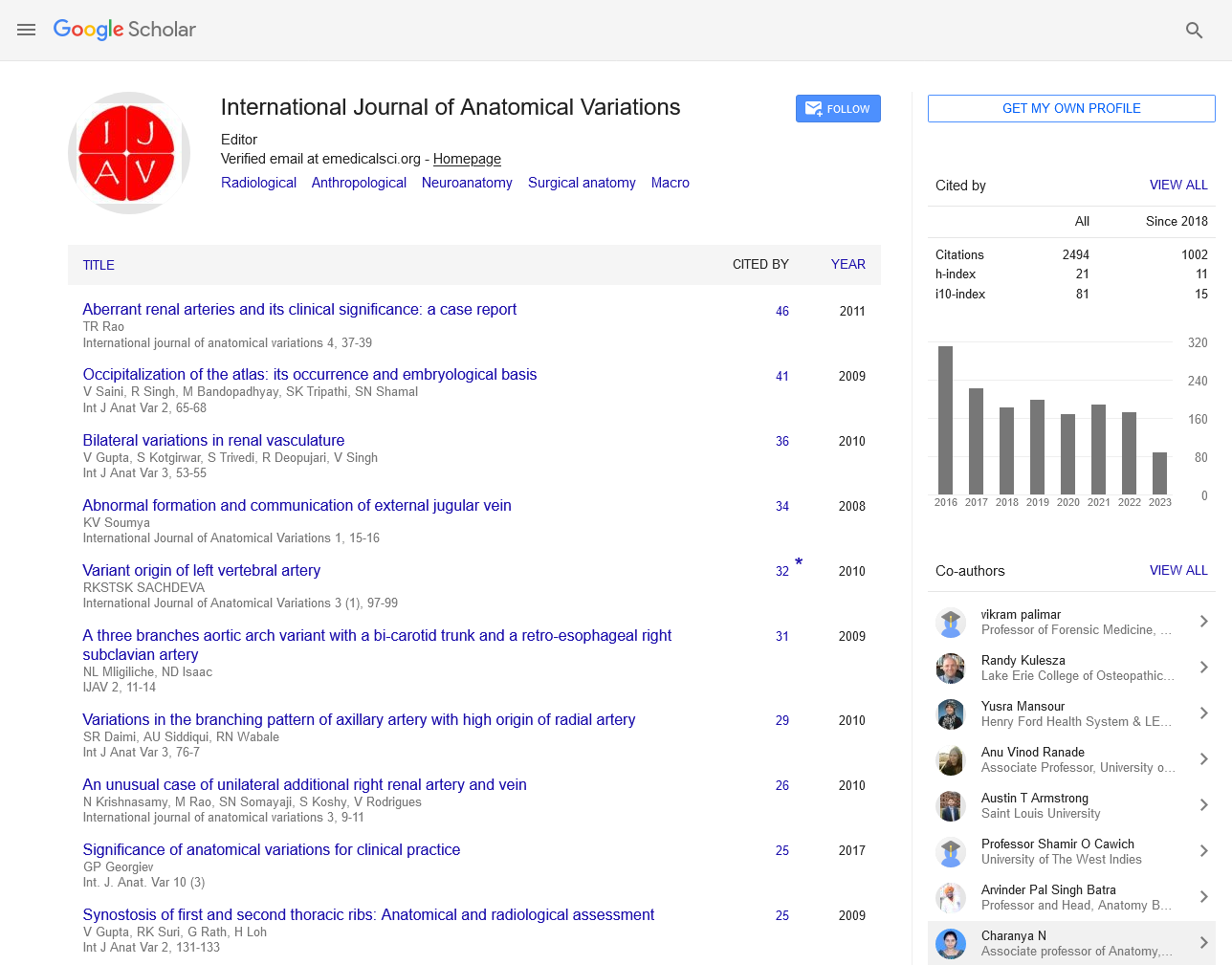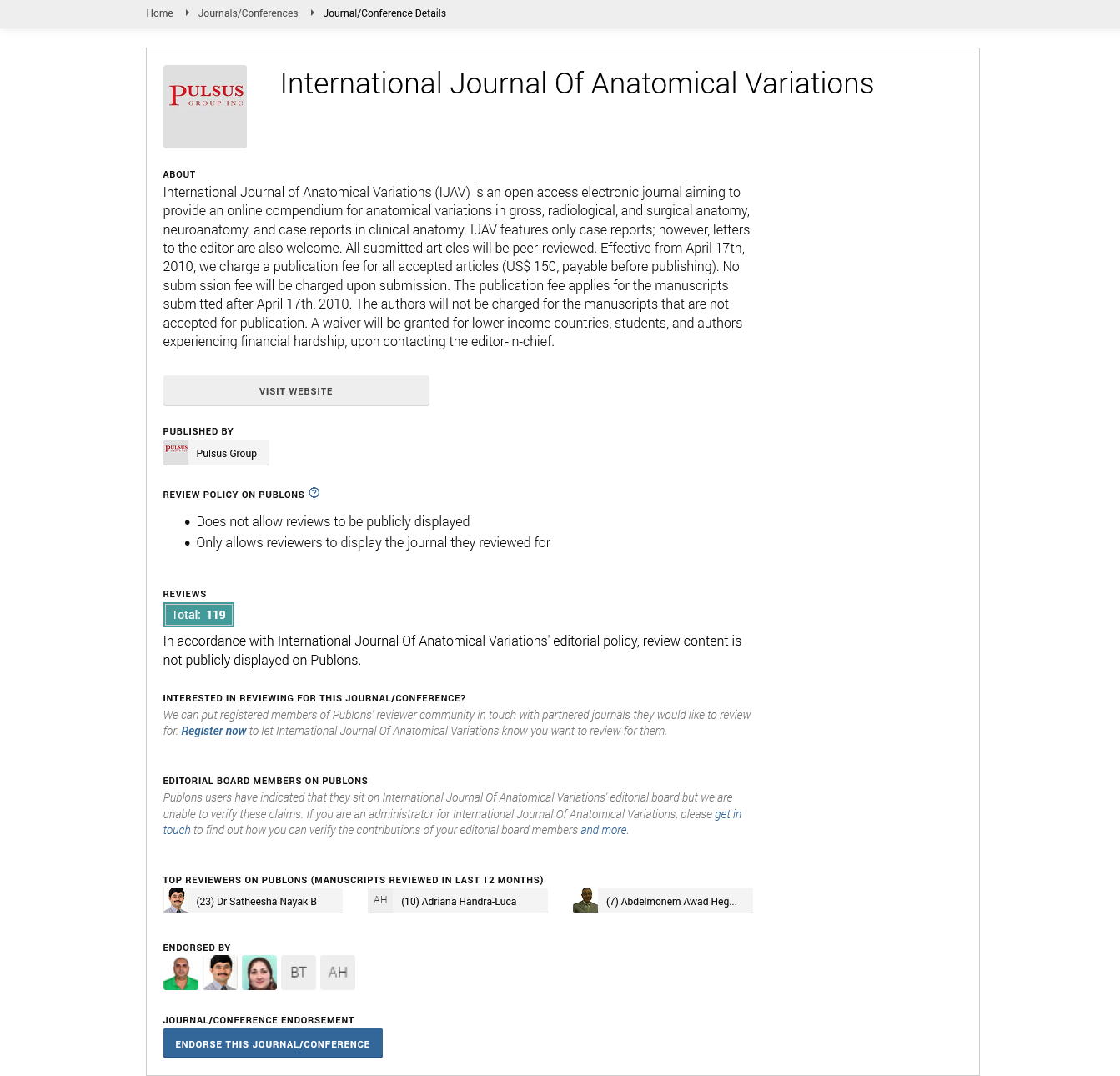Variation in the Anatomy of the Aortic Arch: Consequences for Cardiovascular Imaging and Surgery
Received: 02-Jan-2025, Manuscript No. ijav-25-7544; Editor assigned: 04-Jan-2025, Pre QC No. ijav-25-7544 (PQ); Reviewed: 18-Jan-2025 QC No. ijav-25-7544; Revised: 24-Jan-2025, Manuscript No. ijav-25-7544 (R); Published: 31-Jan-2025, DOI: 10.37532/1308-4038.18(1).476
Citation: Ahmed ZAH. Variation in the Anatomy of the Aortic Arch Consequences for Cardiovascular Imaging and Surgery. Int J Anat Var. 2025;18(1): 721-722.
This open-access article is distributed under the terms of the Creative Commons Attribution Non-Commercial License (CC BY-NC) (http://creativecommons.org/licenses/by-nc/4.0/), which permits reuse, distribution and reproduction of the article, provided that the original work is properly cited and the reuse is restricted to noncommercial purposes. For commercial reuse, contact reprints@pulsus.com
INTRODUCTION
The aortic arch is a critical component of the cardiovascular system, responsible for supplying oxygenated blood to major arteries that branch out to the head, neck, and upper limbs. However, variations in the anatomy of the aortic arch, although relatively rare, can have significant clinical implications, particularly in cardiovascular imaging and surgery. These variations can manifest in different ways, such as changes in the number, course, or branching pattern of the great arteries. Such anomalies may go unnoticed in asymptomatic individuals but pose substantial risks when detected during medical procedures. This article will explore the various anatomical variations of the aortic arch, the potential consequences of these variations for cardiovascular imaging, and the challenges they present during surgical interventions [1].
EMBRYOLOGICAL DEVELOPMENT OF THE AORTIC ARCH
The aortic arch forms early during embryonic development as a component of the primitive heart and vascular system. The aortic arch develops from the paired pharyngeal arch arteries, which arise from the embryonic heart and later differentiate to form the great arteries of the adult circulatory system. In the typical embryological process, these arch arteries undergo a series of transformations and regressions, ultimately leading to the formation of the adult aortic arch with its three primary branches: the brachiocephalic trunk, the left common carotid artery, and the left subclavian artery. However, the normal process of regression and fusion is not always perfect. Variations can occur in the number, position, or connection of the arterial branches that emerge from the aortic arch. These anomalies arise from irregularities in the embryological development of the aortic arches and can manifest as common vascular anomalies such as double aortic arch, right-sided aortic arch, or aberrant subclavian arteries, among others [2].
ANATOMICAL VARIATIONS IN THE AORTIC ARCH
There are several distinct anatomical variations that can occur in the aortic arch, each with its own implications for cardiovascular health and surgical procedures. One of the most common variations is the right-sided aortic arch, which occurs when the aortic arch forms on the right side of the body instead of the left. This variation often involves a mirror image of the typical branching pattern, where the left common carotid artery and left subclavian artery arise from the brachiocephalic trunk. While often asymptomatic, a right-sided aortic arch can complicate surgery in the neck, chest, or heart regions, especially in procedures like coronary artery bypass grafting or thoracic aortic surgery. Another important variation is the double aortic arch, where two aortic arches form, encircling the trachea and esophagus. This condition can lead to compression of these structures, resulting in respiratory or swallowing difficulties. It is often diagnosed in infancy or early childhood, though adult cases can occasionally be detected during imaging for unrelated issues Additionally, aberrant subclavian arteries a condition where the subclavian artery arises abnormally, usually from the descending aorta can present challenges in thoracic surgery. The aberrant subclavian artery may be associated with a right-sided aortic arch, although it can also occur in a normal left-sided arch. This variation can predispose individuals to difficulties during procedures such as thoracic surgery or catheter-based interventions [3].
IMPLICATIONS FOR CARDIOVASCULAR IMAGING
Accurate cardiovascular imaging is essential for diagnosing and managing variations in the anatomy of the aortic arch. Techniques such as computed tomography (CT) angiography, magnetic resonance imaging (MRI), and traditional angiography allow for detailed visualization of the aortic arch and its branches. These advanced imaging modalities are crucial for identifying anatomical variations before surgical or interventional procedures, as they provide high-resolution, three-dimensional images that can help guide the clinician in understanding the exact vascular structure. The presence of an aortic arch variation, such as a right-sided aortic arch or double aortic arch, can complicate the interpretation of imaging results. For example, in the case of a right-sided aortic arch, standard angiographic views may not provide clear identification of the vascular structures, requiring specialized imaging protocols to avoid misinterpretation. Additionally, in the presence of a double aortic arch, it can be difficult to discern the specific course of each arch without advanced imaging techniques. This challenge highlights the need for preoperative imaging to ensure correct diagnosis, especially when dealing with complex anatomical structures that are not immediately apparent on standard views [4].
SURGICAL CHALLENGES AND CONSIDERATIONS
Anatomical variations in the aortic arch can pose significant challenges during cardiovascular surgery. For example, in cases involving a right-sided aortic arch, traditional approaches to coronary artery bypass grafting (CABG) or thoracic aortic repair may be complicated by the altered positioning of the great arteries. Surgeons must carefully plan their approaches to avoid damaging the aortic arch or its branches. Additionally, vascular anomalies like the aberrant subclavian artery, which can arise from the descending aorta or pass behind the esophagus (as in the case of a “vascular ring”), may create difficulties during surgeries involving the esophagus, trachea, or thoracic structures. When performing procedures such as aneurysm repair or arch reconstructions, identifying and accounting for variations in the aortic arch is crucial for avoiding unintended complications. Surgeons may need to adapt techniques or use modified instruments, particularly when addressing vascular anomalies in cases where the arteries diverge from the typical branching pattern. Additionally, the presence of an aberrant subclavian artery or double aortic arch may necessitate careful dissection and potentially complex repair strategies to prevent compression of the esophagus or airway structures. Moreover, during the process of thoracic surgery, such as in lung resections or esophageal surgeries, an abnormal aortic arch may require the surgeon to alter their approach to avoid injury to vascular structures that are not typically encountered in standard procedures. Awareness of these variations helps reduce the risk of postoperative complications like hemorrhage, ischemia, or nerve damage [5].
CONCLUSION
Variations in the anatomy of the aortic arch, though relatively uncommon, can have profound implications for both the interpretation of cardiovascular imaging and the execution of surgical procedures. From a right-sided aortic arch to a double aortic arch or aberrant subclavian artery, each variation presents unique challenges that require careful consideration. Detailed preoperative imaging, particularly using advanced techniques such as CT angiography or MRI, is essential for identifying these variations and planning appropriate surgical strategies. Surgeons must be aware of these anatomical differences to avoid complications and to ensure optimal patient outcomes during procedures involving the aortic arch and its branches. As research and imaging technologies continue to evolve, a deeper understanding of these vascular anomalies will enhance clinical decision-making and improve the safety and efficacy of cardiovascular interventions.
REFERENCES
- Mamikonyan VR, Pivin EA, Krakhmaleva DA. Mechanisms of corneal neovascularization and modern options for its suppression. Vestn Oftalmo. 2016; 132(4):81-87.
- Jun S, Zhang-Y, Chuan C. Postoperative neovascularization, cerebral hemodynamics, and clinical prognosis between combined and indirect bypass revascularization procedures in hemorrhagic moyamoya disease. Clin Neurol Neurosurg. 2021 Sep; 208:106869.
- Xin W, Bofu L. Aortic Dissection with Rare Anatomical Aortic Arch Variation Depicted by Computed Tomography Angiography. Heart Surg Forum. 2021; 24(2): E407-E408.
- Foivos I, Jonathon K, Daryll B. Aberrant right subclavian artery - a rare congenital anatomical variation causing dysphagia lusoria. Vasa. 2021; 504(5):394-397.
- Schizas N, Patris V, Lama N. Arc of Buhler: A lifesaving anatomic variation. A case report. J Vasc Bras. 2012; 37(11):9-326.
Indexed at, Google Scholar, Crossref
Indexed at, Google Scholar, Crossref
Indexed at, Google Scholar, Crossref
Indexed at, Google Scholar, Crossref






